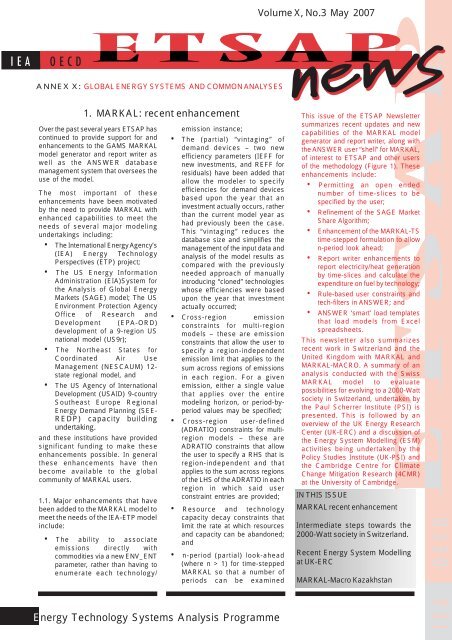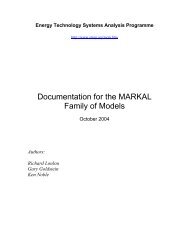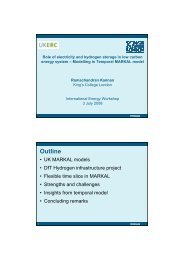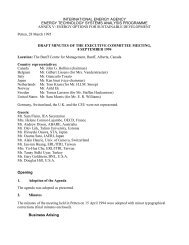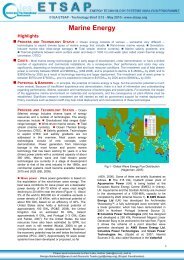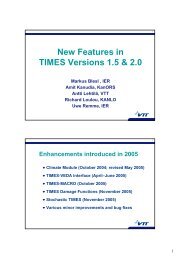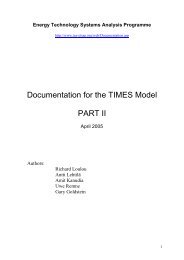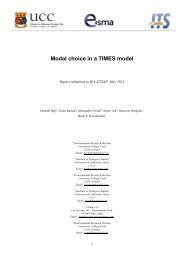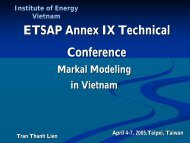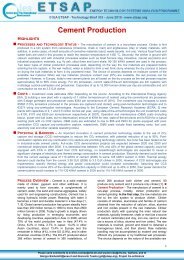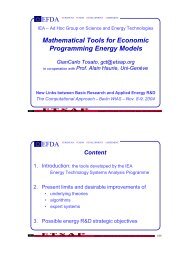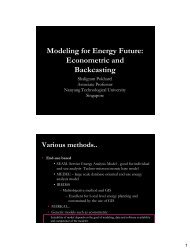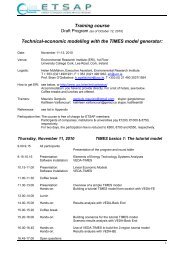Energy Technology Systems Analysis Programme - iea-etsap
Energy Technology Systems Analysis Programme - iea-etsap
Energy Technology Systems Analysis Programme - iea-etsap
You also want an ePaper? Increase the reach of your titles
YUMPU automatically turns print PDFs into web optimized ePapers that Google loves.
Volume X, No.3 May 2007<br />
ANNEX X: GLOBAL ENERGY SYSTEMS AND COMMON ANALYSES<br />
1. MARKAL: recent enhancement<br />
Over the past several years ETSAP has<br />
continued to provide support for and<br />
enhancements to the GAMS MARKAL<br />
model generator and report writer as<br />
well as the ANSWER database<br />
management system that oversees the<br />
use of the model.<br />
The most important of these<br />
enhancements have been motivated<br />
by the need to provide MARKAL with<br />
enhanced capabilities to meet the<br />
needs of several major modeling<br />
undertakings including:<br />
• The International <strong>Energy</strong> Agency’s<br />
(IEA) <strong>Energy</strong> <strong>Technology</strong><br />
Perspectives (ETP) project;<br />
• The US <strong>Energy</strong> Information<br />
Administration (EIA)System for<br />
the <strong>Analysis</strong> of Global <strong>Energy</strong><br />
Markets (SAGE) model; The US<br />
Environment Protection Agency<br />
Office of Research and<br />
Development (EPA-ORD)<br />
development of a 9-region US<br />
national model (US9r);<br />
• The Northeast States for<br />
Coordinated Air Use<br />
Management (NESCAUM) 12-<br />
state regional model, and<br />
• The US Agency of International<br />
Development (USAID) 9-country<br />
Southeast Europe Regional<br />
<strong>Energy</strong> Demand Planning (SEE-<br />
REDP) capacity building<br />
undertaking.<br />
and these institutions have provided<br />
significant funding to make these<br />
enhancements possible. In general<br />
these enhancements have then<br />
become available to the global<br />
community of MARKAL users.<br />
1.1. Major enhancements that have<br />
been added to the MARKAL model to<br />
meet the needs of the IEA-ETP model<br />
include:<br />
• The ability to associate<br />
emissions directly with<br />
commodities via a new ENV_ENT<br />
parameter, rather than having to<br />
enumerate each technology/<br />
emission instance;<br />
• The (partial) “vintaging” of<br />
demand devices – two new<br />
efficiency parameters (IEFF for<br />
new investments, and REFF for<br />
residuals) have been added that<br />
allow the modeler to specify<br />
efficiencies for demand devices<br />
based upon the year that an<br />
investment actually occurs, rather<br />
than the current model year as<br />
had previously been the case.<br />
This “vintaging” reduces the<br />
database size and simplifies the<br />
management of the input data and<br />
analysis of the model results as<br />
compared with the previously<br />
needed approach of manually<br />
introducing “cloned” technologies<br />
whose efficiencies were based<br />
upon the year that investment<br />
actually occurred;<br />
• Cross-region emission<br />
constraints for multi-region<br />
models – these are emission<br />
constraints that allow the user to<br />
specify a region-independent<br />
emission limit that applies to the<br />
sum across regions of emissions<br />
in each region. For a given<br />
emission, either a single value<br />
that applies over the entire<br />
modeling horizon, or period-byperiod<br />
values may be specified;<br />
• Cross-region user-defined<br />
(ADRATIO) constraints for multiregion<br />
models – these are<br />
ADRATIO constraints that allow<br />
the user to specify a RHS that is<br />
region-independent and that<br />
applies to the sum across regions<br />
of the LHS of the ADRATIO in each<br />
region in which said user<br />
constraint entries are provided;<br />
• Resource and technology<br />
capacity decay constraints that<br />
limit the rate at which resources<br />
and capacity can be abandoned;<br />
and<br />
• n-period (partial) look-ahead<br />
(where n>1)fortime-stepped<br />
MARKAL so that a number of<br />
periods can be examined<br />
This issue of the ETSAP Newsletter<br />
summarizes recent updates and new<br />
capabilities of the MARKAL model<br />
generator and report writer, along with<br />
the ANSWER user “shell” for MARKAL,<br />
of interest to ETSAP and other users<br />
of the methodology (Figure 1). These<br />
enhancements include:<br />
• Permitting an open ended<br />
number of time-slices to be<br />
specified by the user;<br />
• Refinement of the SAGE Market<br />
Share Algorithm;<br />
• Enhancement of the MARKAL-TS<br />
time-stepped formulation to allow<br />
n-period look ahead;<br />
• Report writer enhancements to<br />
report electricity/heat generation<br />
by time-slices and calculate the<br />
expenditure on fuel by technology;<br />
• Rule-based user constraints and<br />
tech-filters in ANSWER; and<br />
• ANSWER ‘smart’ load templates<br />
that load models from Excel<br />
spreadsheets.<br />
This newsletter also summarizes<br />
recent work in Switzerland and the<br />
United Kingdom with MARKAL and<br />
MARKAL-MACRO. A summary of an<br />
analysis conducted with the Swiss<br />
MARKAL model to evaluate<br />
possibilities for evolving to a 2000-Watt<br />
society in Switzerland, undertaken by<br />
the Paul Scherrer lnstitute (PSI) is<br />
presented. This is followed by an<br />
overview of the UK <strong>Energy</strong> Research<br />
Center (UK-ERC) and a discussion of<br />
the <strong>Energy</strong> System Modelling (ESM)<br />
activities being undertaken by the<br />
Policy Studies Institute (UK-PSI) and<br />
the Cambridge Centre for Climate<br />
Change Mitigation Research (4CMR)<br />
at the University of Cambridge.<br />
IN THIS ISSUE<br />
MARKAL recent enhancement<br />
Intermediate steps towards the<br />
2000-Watt society in Switzerland.<br />
Recent <strong>Energy</strong> System Modelling<br />
at UK-ERC<br />
MARKAL-Macro Kazakhstan<br />
<strong>Energy</strong> <strong>Technology</strong> <strong>Systems</strong> <strong>Analysis</strong> <strong>Programme</strong>
Figure 1: ETSAP tools and typical applications<br />
[Acronyms: MARKAL = MARKet Allocation; TIMES = The Integrated MARKAL - EFOM System; LP = Linear<br />
Programming; NLP = Non Linear Programming; VEDA = VErsatile Data Analyst; RD&D = Research,<br />
Development & Deployment]<br />
simultaneously, stepping through<br />
one period at a time to solve for<br />
the next n-periods; the 1st period<br />
in each solve is then fixed prior to<br />
stepping forward.<br />
1.2. Major enhancements that have<br />
been added to the MARKAL model to<br />
meet the needs of the EIA-SAGE<br />
model include:<br />
• The ability to run MARKAL in a<br />
time-stepped manner, meaning<br />
investment decisions are made<br />
in each period without knowledge<br />
of future events (often referred to<br />
as myopic or without foresight),<br />
whereas standard MARKAL is run<br />
in a clairvoyant manner; and<br />
• The initial development and<br />
subsequent refinement of the<br />
SAGE MarKeT SHaRe (MKTSHR)<br />
algorithm. The basis of this facility<br />
is to identify market segments or<br />
“groups of competing<br />
technologies” (e.g., all alternative<br />
fueled passenger vehicles), then<br />
accumulate the level of all the<br />
technologies in the market<br />
segment and redistribute to each<br />
technology in the group according<br />
to weighted shares as the relative<br />
cost.<br />
1.3. Major enhancements that have<br />
been added to the MARKAL model to<br />
meet the needs of the US Environment<br />
Protection Agency include:<br />
• The development of a Goal<br />
Programming formulation that<br />
permits the user to explore the<br />
trade-off between conflicting<br />
goals (e.g., least-cost and air<br />
quality) by assigning preferences<br />
to the various objectives being<br />
considered; and<br />
• The introduction of flexible timeslicing<br />
and thereby the removal<br />
of a long-standing MARKAL<br />
restriction that imposed a fixed<br />
segmentation of the electricity<br />
load curve by dividing the annual<br />
demand for and production of<br />
electricity into six distinct timeslices<br />
(3 seasons x 2 diurnal<br />
divisions), and three seasonal<br />
time-slices for heat. With flexible<br />
time-slicing, the user is able to<br />
control the number of seasons<br />
and the number of diurnal<br />
divisions.<br />
1.4. Other significant enhancements<br />
that have been added to MARKAL<br />
over the past several years include:<br />
• The development of a facility to<br />
model Lumpy Investment. This<br />
facility permits more<br />
sophisticated modeling in<br />
respect of lumpy investments<br />
(such as the construction of gas<br />
pipelines) by using mixed integer<br />
programming (MIP) techniques to<br />
model the all-or-nothing building<br />
of new capacity;<br />
• The development of a new<br />
Benefit/Cost report employing a<br />
new GAMS UnitB/C utility;<br />
• The development of a “RAT_FLO”<br />
facility that enables the user to<br />
associate commodity flows in/out<br />
of technologies with ADRATIO<br />
constraints; and<br />
• The provision of improved<br />
2
eporting of results details in the<br />
standard MARKAL tables, so that<br />
electricity/heat generation and<br />
consumption are reported by<br />
time-slice, the expenditure on fuel<br />
is calculated by technology, and<br />
the split of demand devices<br />
output to multiple sectors is<br />
provided.<br />
All the enhancements mentioned<br />
above are fully documented in a series<br />
of MARKAL information notes,<br />
M A R K A L _ v 5 . 3 -<br />
7_EnhancementsUpdates, available<br />
in the ANSWERv6\DOC folder.<br />
In addition, as is discussed in the next<br />
section, there have been numerous<br />
enhancements to the ANSWER data<br />
management system for MARKAL,<br />
notably the introduction of “smart” Excel<br />
workbooks to facilitate the assembling<br />
and loading of the MARKAL data into<br />
ANSWER. These workbooks are<br />
heavily employed in the US9r, NE-12,<br />
and SEE-REDP undertakings, as well<br />
as new capacity building activities with<br />
the state of Ohio and in Nepal.<br />
1.5. Recent ANSWER Enhancements<br />
Over the past several years Noble-Soft<br />
<strong>Systems</strong> has continued to enhance the<br />
ANSWER-MARKAL software interface<br />
so that it supports the majority of<br />
enhancements that have been<br />
incorporated into the MARKAL model<br />
generator and report writer. (While<br />
ANSWER supports running SAGE<br />
time-stepped solve, it does not support<br />
the SAGE Market Share algorithm.) In<br />
addition the ANSWER-MARKAL<br />
software interface has been enhanced<br />
to provide improved power and<br />
convenience to the ANSWER user in a<br />
number of areas.<br />
The most important of these<br />
enhancements have been motivated by<br />
the needs of:<br />
• The International <strong>Energy</strong> Agency’s<br />
<strong>Energy</strong> <strong>Technology</strong> Perspectives<br />
(IEA-ETP) model, and<br />
• The US Environmental Protection<br />
Agency’s US 9-region model.<br />
Briefly, the major enhancements added<br />
to the ANSWER interface (with ETSAP<br />
funding support) to meet the needs of<br />
the IEA-ETP 15 region MARKAL model<br />
involved the creation of a special ETP<br />
version of ANSWER with the following<br />
main characteristics:<br />
• The use of a special Library<br />
Region within an ANSWER<br />
database to store information and<br />
data associated with<br />
technologies and commodities<br />
that are common to each of the<br />
15 regions;<br />
• The provision of extensive bulk<br />
copying and bulk updating<br />
facilities, such as from the Library<br />
Region to each of the 15 regions,<br />
to expedite the task of ensuring<br />
commonality of information and<br />
data across the 15 regions, and<br />
• The creation of an “Operator<br />
Parameter” mechanism that<br />
allows the user to specify regional<br />
multiplier/adder to be applied to<br />
Library Region parameter<br />
numeric values.<br />
The special ETP version of ANSWER<br />
is not generally available to ANSWER<br />
users.<br />
More recently, the following major<br />
enhancements have been added to the<br />
ANSWER interface (with US EPA<br />
funding support) to meet the needs of<br />
the US Environment Protection<br />
Agency’s US 9-region model:<br />
• Support for the newly introduced<br />
MARKAL flexible time-slicing<br />
facility – in particular to simplify<br />
using this facility for multi-region<br />
modeling;<br />
• The introduction of a new<br />
<strong>Technology</strong> Items Filter<br />
(TechFilter) facility that allows the<br />
user to define powerful filters<br />
based on Name and/or<br />
Description and/or Set<br />
Membership and/or Input/Output<br />
Commodity (topology,). Once<br />
defined by the user, these<br />
TechFilters may be “dialed up”<br />
either to filter the Technologies<br />
that are displayed to those of<br />
immediate interest, or as part of<br />
the process of defining “rulebased”<br />
user constraints – see<br />
immediately below. For example,<br />
the <strong>Technology</strong> Items Filter form<br />
shown i Figure 2 defines a filter<br />
that specifies all industrial<br />
demand devices (DMDs) that<br />
consume natural gas (NGA); and<br />
• The introduction of a new “rulebased”<br />
user constraint<br />
(ADRATIO) facility overcoming the<br />
previously cumbersome and<br />
error prone process whereby<br />
each individual technology had to<br />
be explicitly enumerated as part<br />
of the constraint specification. By<br />
use of the TechFilter facility to<br />
specify a set of like technologies<br />
to be involved in the user<br />
constraint, the specification of<br />
many user constraints can be<br />
greatly simplified. Another<br />
important benefit is that “rulebased”<br />
constraints are resolved<br />
at run time, so all qualifying<br />
candidates are picked up and the<br />
user does not have to remember,<br />
when adding new technologies,<br />
to augment old ADRATIOs. For<br />
example the screen snapshot<br />
shown in Figure 3 indicates how<br />
two TechFilters ALL-ELE and<br />
RENEW-ELE (to select all electric<br />
technologies and all renewable<br />
electric technologies<br />
respectively) may be used to<br />
define a “rule-based” user<br />
constraint named RENEWELC<br />
that specifies that production by<br />
renewable electric technologies<br />
must comprise at least 5% of total<br />
electricity production:<br />
The above flexible time-slicing,<br />
TechFilter and “rule-based” user<br />
constraint facilities are now available<br />
to all ANSWER6 users. This includes<br />
a “Resolve Rule-based Constraint”<br />
option that enables the user to crosscheck<br />
the fully enumerated entries<br />
associated with the constraint via a<br />
right-mouse menu option for a<br />
highlighted ADRATIO.<br />
Other significant enhancements that<br />
have been added to the ANSWER<br />
interface over recent years include:<br />
• Strengthening of the Export<br />
Scenario facility to allow the<br />
specification of the start and end<br />
periods for time-series data that<br />
will be exported, and related<br />
strengthening of the Import<br />
Scenario facility;<br />
• The recoding of various parts of<br />
3
Figure 2: Example of new technology items filter<br />
Figure 3:<br />
of rule-based constraints<br />
the ANSWER code to significantly<br />
speed up areas that were running<br />
slowly, for example the Run Model<br />
code has been sped up by a factor<br />
of about 25;<br />
• Improving user-friendliness by<br />
allowing multi-select in various<br />
places (such as selection of<br />
Scenarios for Run Model) where<br />
previously only single select was<br />
possible;<br />
• The introduction of a “Remember<br />
Case Definition” option when<br />
deleting a Case, so that the<br />
Scenarios involved and other<br />
settings are retained online, while<br />
all the actual results for the Case<br />
are deleted; and<br />
• A revised Batch Run facility that<br />
allows the user to readily specify<br />
a set of runs to be carried out one<br />
after the other, further enhanced<br />
by a new Batch Management<br />
facility allowing the user to create,<br />
copy, delete and edit named<br />
Batches of Cases inside an<br />
ANSWER Database. This facility<br />
is used in conjunction with new<br />
[Load Batch] and [Save Batch]<br />
buttons on the Batch Run form to<br />
allow the user to store and hence<br />
easily recall a Batch of Cases to<br />
be re-run.<br />
Finally, and importantly, a completely<br />
new facility – ANSWER “smart” load<br />
templates – has been created to be<br />
used in conjunction with the ANSWER<br />
interface’s “File, Import Model Data<br />
from Excel” facility to load single-region<br />
or multi-region model data from an<br />
4
Excel workbook into an ANSWER<br />
database. The main features of the<br />
“smart” load templates include:<br />
• The new ANSWER “smart” load<br />
templates comprise an Excel<br />
workbook in which the<br />
worksheets have a very flexible<br />
and user-friendly format and<br />
where associated “smart” buttons<br />
(with underlying macros) allow<br />
linking to the user’s ANSWER<br />
database enabling the user to do<br />
such things as selecting an Item’s<br />
Set Memberships/Units from the<br />
ANSWER database, as well as<br />
the other “smart” sheets in the<br />
workbook;<br />
• To specify declaration information<br />
(Name, Description, Units, Set<br />
Memberships, optional<br />
Comment), there are three<br />
declaration worksheets, one for<br />
each of Commodities,<br />
Technologies and Constraints;<br />
• To specify data information, there<br />
are three data worksheets used<br />
for each of Commodity,<br />
<strong>Technology</strong> and Constraint data<br />
respectively, and<br />
• The format of the ANSWER “smart”<br />
load templates simplifies the<br />
specification of declarations and<br />
data for multi-region models that<br />
have common naming<br />
conventions across regions.<br />
The “File, Import Model Data from<br />
Excel” facility has been enhanced to<br />
enable the import into ANSWER of the<br />
6 types of worksheets in the new<br />
ANSWER “smart” load templates. In<br />
addition, the options that are available<br />
on the “Import Model Data from Excel”<br />
form have been extended in a number<br />
of ways to allow the user additional<br />
control over the Import process.<br />
2. Intermediate steps towards the 2000-Watt society in Switzerland: An energyeconomic<br />
scenario analysis 2000-Watt<br />
The <strong>Energy</strong> Economics Group,<br />
Laboratory for <strong>Energy</strong> <strong>Systems</strong><br />
<strong>Analysis</strong>, Paul Scherrer Institute, CH-<br />
5232, Villigen, in Switzerland (CH-PSI)<br />
– Thorsten F. Schulz, Leonardo Barreto,<br />
Socrates Kypreos, Alexander Wokaun<br />
– has been using the Swiss energysystem<br />
MARKAL model for the<br />
examination of intermediate steps<br />
towards the 2000-Watt society in<br />
Switzerland (Schulz, 2007) in the<br />
context of the Swiss National Centre<br />
of Competence in Research on<br />
Climate (NCCR-Climate) funded by<br />
the Swiss National Science<br />
Foundation (SNSF).<br />
The 2000-Watt society, i.e. a Swiss<br />
energy system with a yearly per-capita<br />
primary-energy consumption of 2000-<br />
Watts, has been proposed as an<br />
alternative path to achieve long-term<br />
sustainability goals. Although<br />
ambitious from today’s perspective, a<br />
2000-Watt society could bring benefits<br />
in terms of climate change and security<br />
of energy supply, among others.<br />
An analysis of intermediate steps<br />
towards the 2000-Watt society has<br />
been conducted. Scenarios were<br />
developed of the evolution of the Swiss<br />
energy system up to the year 2050 and<br />
the effect of combined targets on<br />
primary energy consumption per capita<br />
and energy-related CO 2<br />
emissions<br />
were examined.<br />
This analysis has been conducted with<br />
the Swiss energy-system MARKAL<br />
model, a perfect-foresight,<br />
optimisation, “bottom-up” energysystems<br />
model that provides a<br />
detailed representation of energy<br />
supply and end-use technologies for<br />
Switzerland.<br />
This modelling and scenario analysis<br />
suggests that a 2000-Watt society<br />
should be seen as a long-term goal.<br />
During the first half of the 21st century,<br />
only intermediate steps towards this<br />
goal are possible. Feasible<br />
intermediate steps would reduce the<br />
primary energy consumption per capita<br />
in Switzerland to approximately 3.5 kW/<br />
capita in the year 2050 and<br />
simultaneously reduce energy-related<br />
CO 2<br />
emissions by 10% per decade up<br />
to the year 2050 (see Figure 4).<br />
These intermediate steps are<br />
associated with a considerable<br />
transformation of the Swiss energy<br />
system and sizeable costs. Among<br />
others, advanced passenger cars,<br />
energy conservation measures in the<br />
residential and industrial sectors and<br />
biomass-based energy carriers would<br />
need to be key contributors to these<br />
intermediate goals.<br />
The combined scenarios also show<br />
that as the constraint on primary energy<br />
consumption becomes more stringent<br />
the contribution of several of the<br />
energy-supply technologies that could<br />
play a role in fulfilling CO2 reduction<br />
targets, such as nuclear energy and<br />
new renewable energies, is reduced<br />
(see Figure 4). This behaviour is due<br />
to two reasons: on the one hand, a<br />
more stringent constraint implies lower<br />
energy consumption, while on the other<br />
hand, these technologies have<br />
comparatively low conversion<br />
efficiencies between primary-energy<br />
and secondary-energy levels. This fact<br />
makes their contribution to the<br />
constraint on primary energy per capita<br />
less attractive although they could be<br />
important contributors to the fulfilment<br />
of a CO2 reduction target imposed in<br />
isolation. This does of course raise the<br />
question of whether such sources,<br />
particularly the renewable, should<br />
perhaps be accounted for with an<br />
efficiency of 100% instead of a fossil<br />
fuel equivalent, as done in this study,<br />
but that awaits future studies.<br />
Reference<br />
Schulz, T.F., 2007: Intermediate steps<br />
towards the 2000-Watt society in<br />
Switzerland: An energy-economic<br />
scenario analysis. PhD Thesis in<br />
preparation. ETH Zürich. Zürich,<br />
Switzerland.<br />
5
Figure 4: Primary energy per capita mix in Switzerland in the year 2050 for scenarios with an increasingly stringent<br />
constraint on primary energy per capita (labelled “no limit” to “3.5 kW”) imposed in isolation and in combination<br />
with a reduction on CO 2<br />
emissions of 10% per decade up to the year 2050.<br />
3. Overview of the UK <strong>Energy</strong> Research Centre (UK-ERC) and Recent <strong>Energy</strong><br />
System Modelling (ESM) Activities<br />
6<br />
The UK <strong>Energy</strong> Research Centre’s<br />
mission is to be the UK’s pre-eminent<br />
centre of research, and source of<br />
authoritative information and<br />
leadership, on sustainable energy<br />
systems. The Centre was established<br />
in 2004 and is a central part of the £28<br />
million UK cross-Research Councils<br />
programme “Towards a Sustainable<br />
<strong>Energy</strong> Economy” (TSEC)<br />
UK-ERC’s <strong>Energy</strong> <strong>Systems</strong> and<br />
Modelling (ESM) research activities are<br />
being undertaken by the Policy Studies<br />
Institute (UK-PSI) and the Cambridge<br />
Centre for Climate Change Mitigation<br />
Research (4CMR) at the University of<br />
Cambridge. UK-PSI’s core UK-ERC<br />
staff are Professor Paul Ekins, Dr. Neil<br />
Strachan –strachan@psi.org.uk –,<br />
Ramachandran Kannan, and Dr.<br />
Nazmiye Ozkan. 4CMR’s core UK-ERC<br />
staff are Dr. Terry Barker, Dr. Tim Foxon<br />
and Cathy Goss.<br />
In the first 2 years of UK-ERC, the ESM<br />
theme has built comprehensive UK<br />
capacity in E4 (energy-economicengineering-environment)<br />
modelling.<br />
Full and updated working versions of<br />
major UK modelling tools are in place,<br />
notably the technology focused energy<br />
systems MARKAL and MARKAL-<br />
MACRO models, and the macroeconometric<br />
MDM-E3 model –<br />
Multi-sectoral Dynamic <strong>Energy</strong>-<br />
Environment-Economic Model. These<br />
models have been used to address a<br />
range of UK energy policy issues<br />
including long-term carbon reductions,<br />
the role of innovation in the future<br />
energy system, the development of<br />
hydrogen infrastructures, and the<br />
uptake of energy efficiency<br />
technologies and measures. Ongoing<br />
development work is underway to link<br />
these “bottom-up” and “top-down”<br />
energy modelling frameworks in a<br />
hybrid modelling approach.<br />
ESM is focused on the following three<br />
principal activities:<br />
• Modelling the UK energyenvironment-economyengineering<br />
(E4) system. A<br />
principal focus of ESM is its<br />
original research focusing on<br />
academically rigorous and policy<br />
relevant quantification of the
drivers and interactions within the<br />
UK energy-economic system.<br />
This research effort adopts a<br />
“whole-systems”,<br />
multidisciplinary approach,<br />
concentrating on bottom-up/topdown<br />
integration of models.<br />
Additional research focuses on<br />
analytical underpinnings of future<br />
energy scenarios, the role of<br />
innovation, and the systematic<br />
treatment of uncertainty. The<br />
principal modelling tools are the<br />
energy systems MARKAL and<br />
MARKAL-MACRO models and the<br />
macro-econometric MDM-E3<br />
model.<br />
• Mapping UK energy modelling<br />
expertise. A regularly updated<br />
inventory of UK modelling<br />
research has been constructed,<br />
to feed into the UK-ERC<br />
Research Atlas. The aim is to<br />
make UK energy modelling<br />
expertise more accessible to<br />
potential users, and allow<br />
knowledge gaps to be identified<br />
and addressed.<br />
• Networking and co-ordination.<br />
The goal is to develop the<br />
coherence and capacity of UK<br />
energy research modelling, and<br />
deepen the interactions within the<br />
UK and with major international<br />
energy modelling groups. A range<br />
of joint projects, meetings and<br />
conferences aim to develop,<br />
assess and evaluate different<br />
modelling approaches across<br />
the whole range of energy system<br />
issues.<br />
3.1. Selected ESM activities through<br />
March 2007<br />
UK-PSI is coordinating the<br />
construction, calibration and use of the<br />
revised UK MARKAL model. This is a<br />
technology focused dynamic cost<br />
optimization model of the entire UK<br />
energy system from resources through<br />
process, conversion and demand<br />
technologies to sectoral energy service<br />
demands. The subsequent<br />
development of the UK MARKAL-<br />
MACRO model has been a major<br />
analytical underpinning of the 2007<br />
<strong>Energy</strong> White Paper, published in May<br />
2007 (see section below).<br />
Selected highlights:<br />
• A collaborative work programme<br />
was developed between UK-PSI<br />
and AEA to build upon existing UK<br />
modelling expertise and to build a<br />
new version of the UK MARKAL<br />
model.<br />
• Following intensive data collection,<br />
programming, calibration and<br />
review processes the extended<br />
and fully revised new MARKAL<br />
model is now complete.<br />
o Major updates include<br />
resource supply curves, full<br />
depiction of energy<br />
processes and fuel carriers,<br />
nuclear fuel, biomass and<br />
hydrogen energy chains,<br />
remote and decentralized<br />
electricity grids, substantially<br />
greater detail in end-use<br />
sectors (industry, transport,<br />
residential, services and<br />
agriculture).<br />
o Three working papers to<br />
explain the assumptions,<br />
scope and results of the new<br />
model with the aim to increase<br />
transparency were completed<br />
and are now available under<br />
the UK-ERC/ESM working<br />
paper series at: http://<br />
www.UK-ERC.ac.uk/content/<br />
view/295/592.<br />
o<br />
o<br />
An ongoing and stakeholder<br />
exercise involving a range of<br />
bilateral reviews and three<br />
dedicated sectoral<br />
workshops was undertaken.<br />
A major documentation effort<br />
is being undertaken with all<br />
data sources, assumptions,<br />
etc. being made publicly<br />
available, and a major<br />
stakeholder data workshop is<br />
scheduled for 21 June 2007.<br />
o A major methodological<br />
extension to incorporate a<br />
neoclassical macroeconomic<br />
module (the<br />
MARKAL-MACRO model;<br />
Figure 5) was successfully<br />
completed.<br />
• A major analytical input into policy<br />
has been to quantify a range of low<br />
carbon scenarios as a key input<br />
and ongoing analysis for the UK<br />
2007 <strong>Energy</strong> White Paper. This has<br />
involved both the MARKAL and<br />
MARKAL-MACRO models.<br />
· A further application has been to<br />
quantify hydrogen infrastructure<br />
development via the SuperGen<br />
UKSHEC programme – UK<br />
Sustainable Hydrogen <strong>Energy</strong><br />
Consortium.<br />
· Further, the UK model is<br />
contributing in an international<br />
modelling effort on low carbon<br />
societies (LCS) under a joint<br />
Japan-UK research programme<br />
designed to report to the 2008<br />
Japanese G8 presidency.<br />
3.2. 4CMR is coordinating the use and<br />
improvement of the MDM-E3 model<br />
This is a top-down macro-econometric<br />
model with bottom-up sub-models of<br />
the energy sector, the electricity supply<br />
industry (ESI), the household sector<br />
and the transport sector.<br />
Selected highlights:<br />
• The MDM-E3 model was extended<br />
to include policies identified as<br />
contributing to the Government’s<br />
energy efficiency policies as<br />
components in its Climate Change<br />
<strong>Programme</strong> so that the model<br />
could incorporate “bottom-up”<br />
estimates of the effects of the<br />
policies.<br />
• A major research report was<br />
completed for DEFRA –<br />
Department for Environment, Food<br />
and Rural Affairs – on<br />
“Macroeconomic rebound effects<br />
7
Figure 5: MARKAL-MACRO (M-M) model integration<br />
for energy efficiency in the UK”<br />
using the extended MDM-E3<br />
model<br />
• Work is progressing on model<br />
development within MDM-E3,<br />
notably the energy demand submodel,<br />
the existing household<br />
energy sub-model and a transport<br />
energy sub-model.<br />
• Work is ongoing to incorporate<br />
endogenous technological change<br />
into MDM-E3, based on energy<br />
learning curve modelling<br />
developed under the Tyndall<br />
Centre ETech+ project.<br />
3.3 UK-PSI and 4CMR are<br />
undertaking additional modelling and<br />
complementary activities<br />
Selected highlights:<br />
• ESM is the core organizer of an<br />
international energy modelling<br />
collaborative effort designed to<br />
quantify scenarios of low carbon<br />
societies (LCS). This involves 12<br />
international modelling teams,<br />
with a heavy developing country<br />
focus. The output of this project<br />
will feed into the G8 Gleneagles<br />
dialogue when Japan holds the<br />
presidency in 2008, as well as in<br />
a special journal issue of Climate<br />
Policy.<br />
• ESM is a core participant and is<br />
providing analytical support for the<br />
UK-ERC integrating scenarios<br />
research project.<br />
3.4. Networking and Coordination<br />
The goal is to develop the coherence<br />
and capacity of UK energy research<br />
modelling, and deepen the interactions<br />
within the UK and with major<br />
international energy modelling groups.<br />
Selected highlights:<br />
• The 1st ESM Annual <strong>Energy</strong><br />
Modelling Conference (AECM) in<br />
December 2006 focused on longterm<br />
modelling of low carbon<br />
societies. This will be integrated<br />
into the UK-Japan LCS research<br />
project. A conference report and<br />
summary were produced and are<br />
available on the UK-ERC ESM<br />
website at http://www.UK-<br />
ERC.ac.uk/content/view/297/792<br />
• Two major international<br />
workshops on innovation in<br />
energy systems took place at the<br />
UK-ERC Meeting Place in Oxford<br />
in March and September 2006. A<br />
conference proceeding was<br />
produced, and is available on the<br />
UK-ERC ESM website.<br />
• ESM hosted a major international<br />
conference on MARKAL modelling<br />
via the International <strong>Energy</strong><br />
Agency’s ETSAP network. This<br />
was held in Oxford in November<br />
2005, and focused on state-of-theart<br />
international energy technology<br />
modelling, as well as showcasing<br />
the full range of UK energy<br />
modelling programs, a<br />
conference proceeding was<br />
produced.<br />
3.5. Example Project: <strong>Analysis</strong> of<br />
Long-Term carbon reduction<br />
scenarios using UK MARKAL-<br />
MACRO<br />
A major application of the UK MARKAL<br />
energy systems model has been to<br />
quantify the cost and energy system<br />
implications of long-term 60%<br />
reductions in CO 2<br />
emissions. This<br />
project was commissioned by the<br />
Department of Trade and Industry (DTI)<br />
and DEFRA as part of the analytical<br />
underpinning for the 2007 UK <strong>Energy</strong><br />
White Paper <strong>Energy</strong>. The new MARKAL<br />
model has undergone a complete<br />
rebuild with a range of enhancements<br />
8
to improve its analytical sophistication.<br />
In addition, a thorough model and data<br />
validation process were undertaken. A<br />
major methodological extension was<br />
moving to the hard-link neoclassical<br />
macro-economic module (the<br />
MARKAL-MACRO model). This<br />
extension has the advantages of<br />
making energy service demands an<br />
endogenous mitigation response, and<br />
quantifying<br />
macro-economic<br />
implications of large scale CO 2<br />
reductions.<br />
The MARKAL and M-M model runs<br />
focus on characterizing uncertainties<br />
between alternate energy pathways<br />
under scenarios of long-term carbon<br />
reductions.<br />
For this project, the UK MARKAL and<br />
MM runs covered an extensive set of<br />
50 scenarios. These included use of<br />
alternate sets of technology and<br />
conservation data based on the UK-<br />
ERC literature review with technology<br />
expert and stakeholder feedback, with<br />
a second set adjusted for insights from<br />
the DTI <strong>Energy</strong> Review. Scenarios for<br />
base-case and 60% CO 2<br />
reductions by<br />
2050 included:<br />
• Central, high, low cost technology<br />
assumptions;<br />
• Alternate CO 2<br />
emissions<br />
trajectories: constraint imposed<br />
from 2030 or 2010;<br />
• Central, high, low and global fuel<br />
prices;<br />
• Restricted innovation (no<br />
development beyond 2020 or<br />
2010 levels);<br />
• No nuclear/CCS (central cost),<br />
and<br />
• Renewable sensitivity (including<br />
the renewables obligation (RO)<br />
for electricity generation).<br />
Illustrative results are presented below,<br />
focusing on alternate resource fuel<br />
price assumptions, taken from the DTI<br />
energy review (www.dti.gov.uk/energy/<br />
review/page31995.html)<br />
Figure 6 details UK final energy<br />
consumption for the base cases and<br />
60% CO 2<br />
reduction cases under<br />
central, low and high fuel prices<br />
assumptions. Generally higher<br />
resource prices give greater impetus<br />
for energy reductions in both base and<br />
CO 2<br />
constrained scenarios. One<br />
exception is in the CO 2<br />
constrained fuel<br />
price cases, where relative fuel<br />
switching between gas and coal entails<br />
either greater efficiency improvement<br />
(under low price assumptions) or an<br />
increased shift to zero carbon energy<br />
carriers and technologies (under high<br />
price assumptions).<br />
Under such stringent domestic CO 2<br />
reduction targets, all sectors contribute<br />
to emission reduction and increasing<br />
marginal CO 2<br />
prices are detailed in<br />
Figure 7. High resource price<br />
assumptions give lower marginal<br />
prices as the costs of low carbon<br />
technologies and measures are<br />
relatively lower. The M-M model gives<br />
lower prices than the MARKAL model<br />
(marked ST in Figure 7) as its<br />
behavioural response to reduce energy<br />
service demands provides additional<br />
flexibility in meeting the constraint.<br />
A major advantage of the M-M model is<br />
a quantification of macro parameters.<br />
Again higher resource assumptions<br />
lead to a smaller GDP loss as the base<br />
case energy sector has already<br />
decarbonised to a greater extent<br />
meaning achieving the target is easier.<br />
For the full range of scenarios the M-M<br />
model gives a GDP loss varying<br />
between 0.2% and 1.5% (in 2050). This<br />
is equivalent to other estimates (e.g.,<br />
the Stern Review), but the M-M results<br />
may be thought of as a lower bound<br />
Figure 6: Final energy based on resource price assumptions<br />
9
ecause the model does not account<br />
for transition costs, nor (as a UK-only<br />
model) does it account for trade and<br />
competitiveness issues.<br />
A full explanation and analysis of these<br />
scenarios is given in the Final Report<br />
on DTI-DEFRA Scenarios and<br />
Sensitivities using the UK MARKAL and<br />
MARKAL-MACRO <strong>Energy</strong> System<br />
Models available at http://www.UK-<br />
ERC.ac.uk/content/view/142/112<br />
Figure 7: CO 2<br />
prices based on model type and resource price assumptions<br />
4. MARKAL-MACRO-Kazakhstan<br />
A. Cherednichenko (KazNIEK), C. Guivarch (PhD student), G. Sergazina (Climate Change Coordination C), G.C. Tosato (ASATREM)<br />
General framework of the project<br />
In 2004 the EU has funded the TACIS<br />
project “Technical assistance to<br />
Kazakhstan, Kyrgyzstan, Tajikistan,<br />
Turkmenistan and Uzbekistan with<br />
respect to their global climate change<br />
commitments” (map in figure 8). It<br />
aimed at assisting the Central Asian<br />
countries to fulfil their obligations in<br />
respect to the United Nation<br />
Framework Convention of Climate<br />
Change (UNFCCC) and the Kyoto<br />
Protocol (KP). The European<br />
Commission has entrusted SOFRECO<br />
with the technical assistance mission.<br />
For this 30-month 4.5 M€ project<br />
SOFRECO joined with IIASA (Austria),<br />
University of Tuscia (Italy),Agrotec (Italy)<br />
and Natsource (UK).<br />
Specific project objectives were:<br />
• To assist beneficiary countries in<br />
the development of a CDM/JI<br />
institutional infrastructure and<br />
capacity required to implement the<br />
UNFCCC and KP requirements at<br />
the national level;<br />
• To assist the development of the<br />
legal framework;<br />
• To enhance capacity for macroeconomic<br />
modelling needed to<br />
estimate future emission trends,<br />
to evaluate mitigation potential<br />
and related costs, and to develop<br />
climate change abatement<br />
scenarios;<br />
• To enhance awareness among<br />
key policymakers, the business<br />
community and the general public<br />
about climate change, the KP and<br />
the CDM/JI mechanisms for GHG<br />
10
mitigation opportunities.<br />
Projects activities were:<br />
Task 1: to assist in development<br />
of CDM infrastructure<br />
Task 2: to assist in development<br />
of technical capacity for the CDM<br />
Task 3: measures towards<br />
creating JI systems in Kazakhstan<br />
Task 4: legal and institutional<br />
capacity building<br />
Task 5: to strengthen inventory<br />
capacity<br />
Task 6: to enhance economic<br />
modelling capacity<br />
Task 7: training<br />
Task 8: public outreach<br />
Objectives of the energy modelling<br />
task<br />
The Task 6 of the project aimed at<br />
enhancing economic modelling<br />
capacity in Kazakhstan. It includes training<br />
and public outreach. More<br />
specifically it includes the following<br />
subtasks:<br />
• To install MARKAL software in<br />
Kazakhstan;<br />
• To analyse the Kazakh energy<br />
system, in particular,<br />
disaggregate the end-use<br />
sectors;<br />
• To represent it in MARKAL<br />
models, including new<br />
technologies in the supply & enduse<br />
sectors;<br />
• To compile a baseline and alternative<br />
GHG emissions scenarios;<br />
and<br />
• To evaluate CO2 abatement costs<br />
curves.<br />
Content of the final report<br />
The 175-pages final report,<br />
downloadable from http://<br />
www.sofreco.com/projets/c886/<br />
Reports.htm, consists of an executive<br />
summary, three main chapters and a<br />
technical annex / statistical tables.<br />
Chapter 2 analyses the energy system<br />
of Kazakhstan mainly from a domestic<br />
perspective. It focuses on energy<br />
domestic supply and demands – more<br />
than on fossil reserves and production<br />
for export – CO2 emissions and<br />
mitigation options. The energy flows<br />
through the system in late years is<br />
reconstructed with the help of the<br />
reclassified energy balances (the<br />
methodology and the detailed<br />
balances are presented in the<br />
technical annex). Quantitative<br />
information about supply<br />
infrastructures and domestic end-use<br />
devices is sketchier than in other<br />
countries. Also the economics of the<br />
system as a whole is incomplete. GHG<br />
data are good, although sometimes not<br />
fully consistent with the energy flows<br />
(an overview of Kazakh Greenhouse<br />
Gas inventories is reported in the<br />
technical annex).<br />
Chapter 3 describes how the Kazakh<br />
energy system is represented in the<br />
three energy models generated by the<br />
MARKAL tool: technological least cost<br />
(MK), partial equilibrium (PE) and<br />
general equilibrium (MARKAL-MACRO,<br />
M-M). The three models share the<br />
same base demand projections,<br />
primary and final resources availability<br />
and cost, Reference <strong>Energy</strong> System<br />
and technology characterization<br />
database. But the first minimizes the<br />
total discounted energy system cost,<br />
the second maximizes the total<br />
discounted producers and consumers<br />
surplus and the third maximizes the<br />
utility. The three models have been<br />
used to analyse three different sets of<br />
policies. The first set includes<br />
investments in technologies and<br />
command and control policies at the<br />
technological level and it is analysed<br />
through the results of the technological<br />
least cost model. The second set of<br />
policies adds to the first set the<br />
possibility to transmit the energy price<br />
signals to the consumers of energy<br />
services, at a degree variable by sector;<br />
it is analysed through the results of the<br />
partial equilibrium version of the model.<br />
The third set of policies adds to the first<br />
set the possibility to reduce the general<br />
income of all consumers and change<br />
the general price index in the country; it<br />
is simulated by the MARKAL-MACRO<br />
Kazakhstan model. The methodology<br />
is briefly described in the technical<br />
appendix.<br />
Chapter 4 describes the scenarios run<br />
with the three models (table 1 lists the<br />
mitigation scenarios, without variants).<br />
Figure 8: General map of Central Asian Countries<br />
Conclusions<br />
The analysis highlights under what<br />
conditions Kazakhstan benefits from<br />
the participation to the KP as Annex I<br />
(i.e. with binding commitments). Figure<br />
9 compares possible revenues from<br />
selling CO2 emission rights to<br />
countries willing to invest in Kazakh<br />
power plants and energy processes<br />
11
with the cost for Kazakhstan of reducing<br />
its own domestic emissions. The costgoal<br />
for internal mitigation options<br />
depends on the international market<br />
for emission permits.<br />
ETSAP News ISSN 13823264<br />
The ETSAP Newsletter is published under annex X<br />
"Global <strong>Energy</strong> <strong>Systems</strong> and Common Analyses"<br />
of the International <strong>Energy</strong> Agency Implementing<br />
Agreement for a <strong>Programme</strong> of <strong>Energy</strong> <strong>Technology</strong><br />
<strong>Systems</strong> <strong>Analysis</strong> (IEA/ETSAP)<br />
Executive Committee Members:<br />
Chairman<br />
H. Labib<br />
Vice Chair<br />
A. Fierens<br />
Vice Chair<br />
M. Nagai<br />
The tools setup during this process<br />
are now available to all interested<br />
groups and experts for evaluating<br />
additional policies, running alternative<br />
scenarios and improving the MARKAL-<br />
MACRO Kazakhstan models.<br />
Table 1: List of mitigation scenarios<br />
analysed with the MARKAL-Kazakhstan<br />
models<br />
The objective of the ETSAP Newsletter is to keep<br />
ETSAP participants and the wider energy planning<br />
and modelling community informed of<br />
advancements in the methodology and tools, as<br />
well as the status of significant projects completed,<br />
underway, or in the planning stage employing the<br />
ETSAP Tools.<br />
Operating agent<br />
GianCarlo Tosato (ASATREM S.r.l)<br />
Tel.: +39 335 537 7675<br />
e-mail: gct@<strong>etsap</strong>.org<br />
http://www.<strong>etsap</strong>.org<br />
IEA Desk Officer<br />
Peter Taylor<br />
Tel: +33 1 4057 6683<br />
e-mail: Peter.Taylor@<strong>iea</strong>.org<br />
http://www.<strong>iea</strong>.org<br />
BELGIUM<br />
CANADA<br />
DENMARK<br />
EU<br />
FINLAND<br />
GERMANY<br />
GREECE<br />
ITALY<br />
JAPAN<br />
KOREA<br />
SWEDEN<br />
SWITZERLAND<br />
THE NETHERLANDS<br />
A. Fierens<br />
H. Labib<br />
K. Karlsson<br />
M.R. Virdis<br />
S.Tuhkanen<br />
A. Voss<br />
G. Giannakidis<br />
V. Cuomo<br />
M. Nagai<br />
J-W. Noh<br />
K. Hammes<br />
S. Kypreos<br />
K. Smekens<br />
Editor<br />
Gary Goldstain - USA<br />
Tel: +1 (631) 725 1869<br />
e-mail: ggoldstein@irgltd.com<br />
TURKEY<br />
UK<br />
US<br />
T.S. Uyar<br />
S. Pye<br />
C. Difiglio<br />
Figure 9: Trade-off between growing domestic mitigation levels and revenues of emission trading<br />
12


